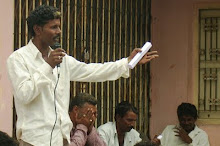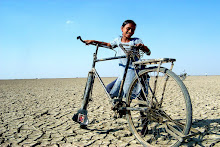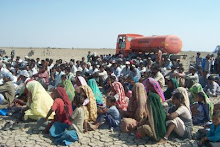Livemint:
New Delhi: Saturday, 12 March 2016.
In the Little
Rann of Kutch in Gujarat, mirrors are one way to reach out to each other.
In this era
of real-time communication where mobile phones in many ways define the human
experience, there’s still a place in our country where people communicate with
each other by way of reflecting mirrors. In the Little Rann of Kutch in
Gujarat, mirrors are one way to reach out to each other.
According to
the salt department of India (bit.ly/1UaTNh3) about 76% of the total salt
produced in India comes from Gujarat. And the Little Rann (the Kutch desert is
divided into the Little Rann and the Great Rann) in Gujarat has a role to play
in this.
The 4,953 sq.
km Little Rann, home to about 3,500 families belonging to the Agariya (salt
worker) community, is known as India’s “Survey Number Zero” because no land
survey has been conducted here since the British left. Several attempts have
been made by activists working in the region to get government officials to
come and see the living conditions here.
Yet, the
majority of the Agariyas continue to live a life of virtual non-identity and
are mostly paid poorly by middlemen for their labour.
The entire
Little Rann was notified as a wildlife sanctuary in 1973 and, since 2006,
exists inside a wild ass sanctuary. The forest department wants the Agariyas to
leave. The department claims that there are no more than 300 Agariya families, who
will be rehabilitated if they agree to move out.
The Agariyas
are pacifists who do not in any way harm the endemic wild asses that number
some 5,000. The animals, incidentally, can’t survive in the salt desert, and
usually take shelter on the periphery of the sanctuary to graze and feed in
places where the Agariyas have their farms.
The Agariya
community is a de-notified tribe scheduled that has been farming salt for
centuries, generation after generation. In their language, agar means salt and
those who farm it are called Agariyas. Their lives are divided into two: eight
months in the saltpans and the remaining four in villages on the periphery of
the Little Rann.
From
September to almost June, the entire Little Rann area turns dry and arid. This
is when the Agariyas come to the desert and put up their shacks and reclaim
their traditionally demarcated wells to produce salt. The Little Rann is
submerged under rain water for four months, when the Agariyas return to the
villages on its periphery.
This peculiar
lifestyle means that their children hardly ever get a chance to go to school.
When I visited the Little Rann, I got a chance to see about 17 schools made of
rugs and sacks around the area of about 10-20 km from Patadi block headquarters
of Surendra Nagar district.
These schools
are supported by an Ahmedabad-based forum for voluntary organizations called
Janpath.
When a
volunteer teacher comes to any of the 10x10 ft cubicle schools made from jutes
and sacks, the teacher bounces off sunlight through a piece of mirror in all
directions, informing Agariyas living in the huts nearby to send their
children. The children are then dropped off on motorbikes by their fathers or
other men of the family.
In 2016, the
challenge is how to utilize digital tools to help the Agariyas to assert their
identity, prove their existence to the government system and improve their
communication.
Together with
Janpath and several active Agariya members, we sat and agreed to do a few
simple things. The first was to develop a location-based census app to survey
the Agariyas in the salt desert as well as in the village. It would be
necessary to ensure the surveys are done by the Agariya community members
through computer tablets.
The digital
census would be designed with official norms of census, but additionally will
include location details and photos. It would be with the help of school
children who will also be made digitally literate thanks to this plan.
Secondly, we
want to broadcast by broadband Internet from Patadi block in Surendranagar
district, headquarter to most of the government schools in and around Little
Rann to all schools using wireless technologies like Line of Sight and use of
unlicensed spectrum such as 2.4 gigahertz and 5.8 gigahertz. Each school will
have a customized single-rod tower with a receiving and relaying modem.
We propose to
have a motorcycle mounted with a carrier for transporting four to six tablets.
The motorcycle will go from school, spending about two hours in each with
children. It will cover three schools a day.
In a week,
the bike will cover all the 17 schools in the area and each school children
will have access to content through the Internet. This will be the start of
their digital literacy education.
We also aim
to provide a centralized digital resource center connected with broadband for
the exclusive use of the Agariya community for all their day-to-day needs of
information. And finally, we want to organize the Agariyas into self-help groups
and use the digital communication medium to help them to understand their
market and work for themselves rather than traders.
With the
intervention of digital tools, we are hoping that the community will gradually
reclaim their status of salt farmers rather than being referred to as saltpan
workers with legal identity of existence.
What is now needed
is some philanthropic fund to support these ideas which can help the Agariyas
leave behind the morass of poverty and disempowerment and find for themselves a
place in mainstream India.
(Osama
Manzar is founder-director of the Digital Empowerment Foundation and chair of
the Manthan and mBillionth awards. He is co-author of NetCh@kra – 15 Years of
Internet in India and Internet Economy of India.)
















.jpg)
.jpg)
.jpg)
.jpg)













No comments:
Post a Comment